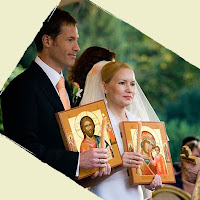 The well-being of society in any culture depends primarily on the family, how it functions, and on what foundations it’s built and maintained. The scriptures of the Old and the New Testaments used to be the source book of Christian marriage and family life, but even for the majority of Christians, this is no longer true. In the Orthodox faith, we may have a better grasp of these truths, we still know them and are expected to follow them, because the Church has yet to follow the world in playing games with marriage and the rules. Who knows how long this will last, though, because even in the Orthodox Church, the world takes its toll of broken marriages and families, while the Church looks on, sometimes, uncomprehending, unable to help. This is a tragedy that casts its dark shadow even on the inner walls of the Church.
The well-being of society in any culture depends primarily on the family, how it functions, and on what foundations it’s built and maintained. The scriptures of the Old and the New Testaments used to be the source book of Christian marriage and family life, but even for the majority of Christians, this is no longer true. In the Orthodox faith, we may have a better grasp of these truths, we still know them and are expected to follow them, because the Church has yet to follow the world in playing games with marriage and the rules. Who knows how long this will last, though, because even in the Orthodox Church, the world takes its toll of broken marriages and families, while the Church looks on, sometimes, uncomprehending, unable to help. This is a tragedy that casts its dark shadow even on the inner walls of the Church.Here are a few thoughts on marriage from an Orthodox perspective, written to a young couple getting ready to take the plunge. Entering into any relationship always requires leaps of faith, all the more with marriage since it’s a relationship “for keeps.”
First, what’s going on in your latest “hard talk” is a necessary step in your growing relationship.
 It’s what I would call the “constitutional” stage. You need to sort out right at the beginning what the “constitution” of your marriage is, “in order to form a more perfect union…” Of course, for you both, the constitution is the Word of God, Jesus is your Mediator, the Bible your written document to refer to.
It’s what I would call the “constitutional” stage. You need to sort out right at the beginning what the “constitution” of your marriage is, “in order to form a more perfect union…” Of course, for you both, the constitution is the Word of God, Jesus is your Mediator, the Bible your written document to refer to.The order of marriage, that is, how it works, is pretty clear in the Bible—too clear for most modern people.
“Christ is the head of every man, man is the head of woman, and God is the head of Christ,” (1 Corinthians 11:3) and everything that this verse implies, being amplified and explained and examples of it given in the rest of the Bible.
In Christ there are ‘priesthoods,’ conveyed by means of ta mystiría, “the mysteries.”
The first one is basic, which you receive when you receive Christ (give your permission to Him to be Lord of your life), are baptized and chrismated. That chrismation (anointing) is the symbolic act whereby you are joined (the meaning of sym-bolos, “together-thrown”) to Christ and become one of the royal priesthood, the holy nation. Everyone in Christ is called to be that, as bishop Anthony used to teach, and their ministry and witness is to do 90% of what “ordained clergy” can do.
 Another priesthood is marriage, which you receive when you declare that you are one flesh with your betrothed. Here, both the man and the woman give each other permission to each other’s all, which is the only kind of permission that can produce a Godly family. The woman and man covenant with each other to follow what the Bible says marriage is, respecting its order. Their ministry and witness is to produce a family in Christ.
Another priesthood is marriage, which you receive when you declare that you are one flesh with your betrothed. Here, both the man and the woman give each other permission to each other’s all, which is the only kind of permission that can produce a Godly family. The woman and man covenant with each other to follow what the Bible says marriage is, respecting its order. Their ministry and witness is to produce a family in Christ.Another priesthood is the ordained ministry. A man must be married, ideally, so that his marriage witness can be the foundation of his now expanded witness and responsibilities. Notice that though the man is the head of the woman, the man cannot be ordained to this priesthood without his wife’s explicit permission. Once she gives it, she acknowledges that both of them have become bondservants of Christ, and the ministry and witness of both of them, individually and as a married couple, now have added dimensions.
The reason I gave this example of the step by step process is to illustrate how, in Orthodoxy at least, the relationship of husband to wife follows the scriptures but within constitutional limits. There is a divine and merciful order in all that our God has prescribed for us.
 If we follow it, then there is no danger and nothing to fear in entering the marriage covenant, for either party. If we begin to deviate and try to adapt it to fit our preference, things start to go wrong.
If we follow it, then there is no danger and nothing to fear in entering the marriage covenant, for either party. If we begin to deviate and try to adapt it to fit our preference, things start to go wrong.The fear that the woman will be considered an “inferior” by her husband is a false fear driven by worldly thinking. There is no “superior” and “inferior” in Christ, but there is order. In the Bible, the matriarchs are all examples of womanliness, and when we read of their submission to their husbands, do we ever get a feeling of inferiority? Ruth, in fact, was so devoted to her husband that when he died she transferred her obedience to his mother Naomi, “I will go where you go, your people will be my people.” Do we ever get the feeling that Ruth was “inferior” in fact or feeling when we read this story? Quite the contrary, she is seen by us as heroic.
In His divine order for our relationships with each other, God gives us not opportunities for bondage but for freedom. He transforms us from rootless plants to “deep-rooted trees by streams of water” (Psalm 1, Mizmor Aleph). He starts with our basic raw natures which are full of fear and doubt and weakness, and He transforms us into heroes.

That is why the Orthodox marriage service culminates in the procession around the marriage altar singing the song of the 40 martyrs of Sebaste, the presbyter leading the couple by the hand—bridegroom in front, bride following—while with his other hand he holds aloft as a beacon or torch, the golden-clad Word of God, the Gospels.
Your marriage is an inviolable tabernacle, a sort of Holy of Holies that no one, not even your future children, can penetrate. This is a given, and knowing this should dispel any man’s or woman’s fear of “what might happen.” The man creates with his brothers the outer world, he protects, he acquires, he extends the borders, he takes captives (for Christ). The woman creates with her sisters the inner world, the hearth, the home, the nurture of children, the sanctuary and paradise of her husband. This is what comes out of our following of Christ in the priesthood of marriage.
In the Orthodox marriage service this is seen in numerous places, and the basic concept of the crowning symbolizes the martyría (Greek, “witness”) of marriage. As with Christ, this martyría has two aspects, the cross, and paradise. Christ’s death on the cross opened for us who believe the gates of paradise. In marriage, our deaths to ourselves open for us and also for our children the gates of paradise, making the Christian family and home an ikon of paradise. That’s why a man and woman are crowned as king and queen, as Adam and Eve, and their future family and home, blessed as Paradise.
Work these things through with each other, get your “constitution” in order “for a more perfect union.” God is with you.
 “Bridegroom! Be exalted like Abraham, blessed like Isaac and multiplied like Jacob, walking in peace and righteously doing God’s commandments. And you, O bride! Be exalted like Sarah, gladdened like Rebecca and multiplied like Rachel, being happy with your husband and keeping the precepts of the Law!”
“Bridegroom! Be exalted like Abraham, blessed like Isaac and multiplied like Jacob, walking in peace and righteously doing God’s commandments. And you, O bride! Be exalted like Sarah, gladdened like Rebecca and multiplied like Rachel, being happy with your husband and keeping the precepts of the Law!”in the Orthodox Wedding Service












































